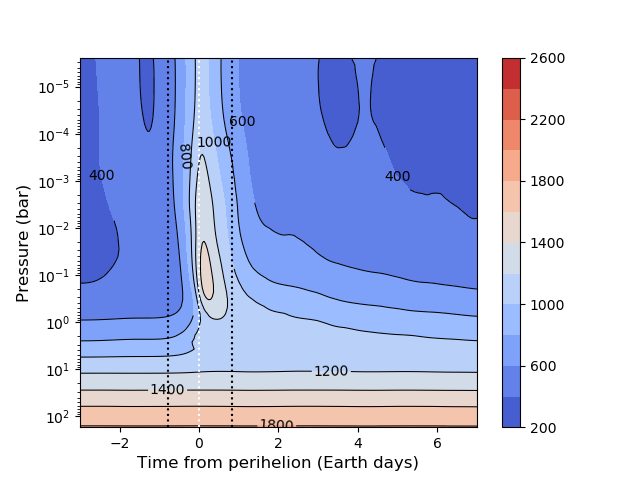Compositional Variations of the Highly Eccentric Planet HD 80606b
- 1University of Oxford, Atmospheric, Oceanic and Planetary Physics, Department of Physics, Oxford University, UK (shang-min.tsai@physics.ox.ac.uk)
- 2Lunar and Planetary Laboratory, University of Arizona, Tucson, AZ, 85721, USA
- 3Carl Sagan Institute, Cornell University, USA
The hot Jupiter HD 80606b has an extremely eccentric orbit (e ~ 0.93). The stellar irradiation the planet received drastically increases by more than two orders of magnitude during the perihelion passage. The variation due to eccentric orbits provides unique opportunities to directly probe the dynamical, radiative, and chemical timescales. To understand the interplay between these processes, we set up a model framework to explore the atmospheric response. We first run three-dimensional general circulation models of HD 80606b using MITgcm [1] for various atmospheric metallicities and internal heat. Based on the hemispheric-averaged results from the GCM, we then time-step the 1D photochemical model VULCAN [2] along the orbits to investigate the compositional response in detail. The kinetics results show that efficient vertical mixing leads to deep quench levels of CO and CH4. Because of the depth of quench levels where the radiative timescale is long, the temperature variations have no effects on the quenching behavior. Instead, photolysis and the rapid heating in the upper stratosphere is the main driver of the time-dependent chemistry. We find a transient state of [CO]/[CH4] > 1 after the perihelion. Since the quenched abundances of CO and CH4 are independent of the orbital phase, the [CO]/[CH4] ratio can provide constraints on the metallicity and internal heat. In addition, we find a sequence of sulfur species initiated by the sudden thermal and photochemical forcing near perihelion, which can be potential signatures for the existence of sulfur on hot Jupiters.

Figure 1. Dayside averaged temperature as a function of time relative to perihelion from the 3D general circulation model, assuming solar metallicity and Tint =100 K. The white dotted line indicates perihelion and the black dotted lines enclose the period where the planet is in synchronous rotation.
Figure 2. The dayside-averaged CO mixing ratio as a function of time relative to perihelion (left), compared to the hypothetical scenario where the planet is fixed at each orbital location (right) to isolate the orbital effects.
How to cite: Tsai, S.-M., Steinrueck, M., Parmentier, V., Lewis, N., and Pierrehumbert, R.: Compositional Variations of the Highly Eccentric Planet HD 80606b, Europlanet Science Congress 2021, online, 13–24 Sep 2021, EPSC2021-684, https://doi.org/10.5194/epsc2021-684, 2021.

